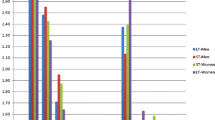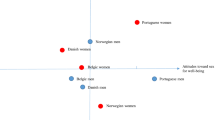Abstract
Sex-role orientation based on combined t-ratio/median-split scoring of Personal Attributes Questionnaire data was investigated in relation to intimacy status in a sample of university alumini with an average age of 25 years. There was no significant sex difference in sex-role orientation or social status. As expected, androgyny was associated with the preintimate status in both men and women. Contrary to prediction, androgyny was also associated with the less intimate statuses of merger in men and pseudointimate in women; sex-typing was associated with the most intimate status in both sexes. All sex-typed individuals were involved in long-term, heterosexual partnership varying in level of intimacy.
Similar content being viewed by others
References
Abrahams, B., Feldman, S. S., & Nash, S. C. Sex role self-concept and sex role attitudes: Enduring personality characteristics or adaptations to changing life situations? Developmental Psychology, 1978, 14, 393–400.
Baumrind, D. Are androgynous individuals more effective persons and parents? Child Development, 1982, 53, 44–75.
Bem, S. L. The measurement of psychological androgyny. Journal of Consulting and Clinical Psychology, 1974, 42, 155–162.
Bem, S. L. On the utility of alternative procedures for assessing psychological androgyny. Journal of Consulting and Clinical Psychology, 1977, 45, 196–205.
Constantinople, A. An Eriksonian measure of personality development in college students. Developmental Psychology, 1969, 1, 357–372.
Erikson, E. H. Childhood and society (2nd ed.). New York: W. W. Norton, 1963.
Feldman, S. S., Biringen, Z. C., & Nash, S. C. Fluctuations of sex-related self-attributions as a function of stage of family life cycle. Developmental Psychology, 1981, 17, 24–35.
Feldman, S. S., & Nash, S. C. Sex differences in responsiveness to babies. Developmental Psychology, 1979, 15, 430–436.
Helmreich, R. L., Spence, J. T., Beane, W. E., Lucker, G. W., & Matthews, K. A. Making it in academic psychology: Demographic and personality correlates of attainment. Journal of Personality and Social Psychology, 1980, 39, 896–908.
Helmreich, R. L., Spence, J. T., & Wilhelm, J. A. A psychometric analysis of the Personal Attributes Questionnaire. Sex Roles, 1981, 7, 1097–1108.
Helmreich, R., Stapp, J., & Ervin, C. The Texas Social Behavior Inventory (TSBI): An objective measure of self-esteem or social competence. JSAS Catalog of Selected Documents in Psychology, 1974, 4, 79. (Ms. No. 681)
Jones, W. H., Chernovetz, M. E., & Hansson, R. O. The enigma of androgyny: Differential implications for males and females? Journal of Consulting and Clinical Psychology, 1978, 46, 298–313.
Kelly, J. A., O'Brien, C. G., & Hosford, R. Sex roles and social skills considerations for interpersonal adjustment. Psychology of Women Quarterly, 1981, 5, 758–766.
Myers, A. M., & Sugar, J. A critical analysis of scoring the BSRI: Implications for conconceptualization. JSAS Catalog of Selected Documents in Psychology, 1979, 9, 24, (Ms. No. 1833)
O'Conner, K., Mann, D. W., & Bardwick, J. M. Androgyny and self-esteem in the upper-middle class: A replication of Spence. Journal of Consulting and Clinical Psychology, 1978, 46, 1168–1169.
Orlofsky, J. L., Marcia, J. E., & Lesser, I. M. Ego identity status and the intimacy versus isolation crisis of young adulthood. Journal of Personality and Social Psychology, 1973, 27, 211–219.
Orlofsky, J. L., Aslin, A. L., & Ginsburg, S. D. Differential effectiveness of two classification procedures on the Bem Sex Role Inventory. Journal of Personality Assessment, 1977, 41, 414–416.
Pedhazur, E. J., & Tetenbaum, T. J. Bem Sex Role Inventory: A theoretical and methodological critique. Journal of Personality and Social Psychology, 1979, 37, 996–1016.
Puglisi, J. T., & Jackson, D. W. Sex role identity and self-esteem in adulthood. International Journal of Aging and Human Development, 1981, 12, 129–138.
Sedney, M. A. Comments on median split procedures for scoring androgyny measures. Sex Roles, 1981, 7, 217–222.
Silvern, L. E., & Ryan, V. L. Self-rated adjustment and sex-typing in the Bem Sex-Role Inventory: Is masculinity the primary predictor of adjustment? Sex Roles, 1979, 5, 739–763.
Spence, J. T., & Helmreich, R. L. Masculinity and femininity: Their psychological dimensions, correlates, and antecedents. Austin: University of Texas Press, 1978.
Spence, J. T., & Helmreich, R. L. On assessing “androgyny.” Sex Roles, 1979, 5, 721–738.
Spence, J. T., Helmreich, R., & Stapp, J. The Personal Attributes Questionnaire: A measure of sex role stereotypes and masculinity-femininity. JSAS Catalog of Selected Documents in Psychology, 1974, 4, 43. (Ms. No. 617)
Spence, J. T., Helmreich, R., & Stapp, J. Ratings of self and peers on sex-role attributes and their relation to self-esteem and conceptions of masculinity and femininity. Journal of Personality and Social Psychology, 1975, 32, 29–39.
Tesch, S. A. Intimacy and identity development in early adulthood (Doctoral dissertation, University of Rochester, 1980). Dissertation Abstracts International, 1980, 41, 2000A. (University Microfilms No. 80–23, 945)
Tesch, S. A., & Whitbourne, S. K. Intimacy and identity status in young adults. Journal of Personality and Social Psychology, 1982, 43, 1041–1051.
Waterman, A. S., & Whitbourne, S. K. Androgyny and psychosocial development among college students and adults. Journal of Personality, 1982, 50, 121–133.
Author information
Authors and Affiliations
Additional information
Part of this research was included in a presentation at the Annual Convention of the American Psychological Association, Montreal, September 1980. The author thanks Susan Krauss Whitbourne for providing advice and intimacy status ratings for this research.
Rights and permissions
About this article
Cite this article
Tesch, S.A. Sex-role orientation and intimacy status in men and women. Sex Roles 11, 451–465 (1984). https://doi.org/10.1007/BF00287472
Issue Date:
DOI: https://doi.org/10.1007/BF00287472




